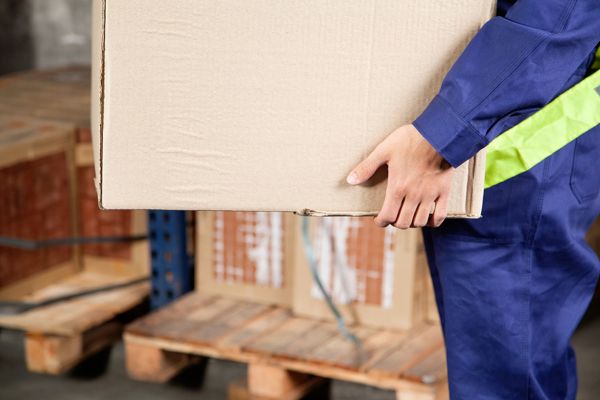Manually Handling Materials

The best way to handle boxes and cartons is to grasp the opposite top and bottom corners and draw a corner between your legs before lifting. Long pieces of pipe, bar stock or lumber should be carried over a padded shoulder with front end held high to avoid hitting other employees. Special caution should be used at corners.
There are several areas in material handling that require considerable skill - the rolling of heavy round objects and the handling of heavy barrels and drums. Special training and devices should be used before attempting to handle these tough items manually.
Needless to say, you've probably already encountered your share of slivers, loose hardware or anything else that could cause injuries. Again, good work gloves are helpful.
Regular inspection of tools and equipment is important. A dull or faulty tool can cause an injury to you and a cracked handle could mean an injury for you or your neighbor. So, be sure to report damaged equipment.
We can't mention too often the importance of using the right tool for the job. Don't attempt to use your fingers as a pry, a wrench for a hammer, or a screwdriver for a chisel; you'll just be inviting a painful injury.
Handling of materials does not necessarily mean we have to become engaged in hand-to-hand combat with them, but the results may be the same if we don't use all available protection and precautions.
You don't have to be involved in manual material handling very long to discover there's a hard way and an easy way to do things. And maybe you've also discovered that the easy way isn't always the safe way. Skinned knuckles or pinched fingers are instant reminders that something wasn't done correctly. So for a few moments let's review some of the precautions to protect ourselves while handling materials.
First, considerable hand protection can be gained by wearing work gloves. They can prevent many cuts and scratches and many types also give a better grip. Most work gloves are ventilated for the comfort of the wearer, so there's no qood excuse for not wearing them when the occasion calls for them.
Conservation of space is important but sometimes we tend to pile things too close to a wall or column. Proper clearance at the top and on all sides of piles is necessary for safety. When material is piled, it should be in stacks that will stand steady. Sometimes this means that the materials must be criss-crossed or interleaved with corrugated board. Objects that roll should be chocked. When a pile falls, serious injury and damage can result. Piling too high, or in a manner that will interfere with lighting or circulation of air, should be avoided.
Don't be afraid of putting the cleaning crew out of a job by picking up things that you drop on the floor. Tripping and slipping hazards could put both you and the cleaners out of work for a long time. Keep tools and other articles in the right bin or drum and wipe up spills right away.
Injuries resulting from lifting are a continual problem both on and off the job. Most of us know we should crouch close to the load and then use leg muscles to lift. However, after the lift has been made, it's very important to turn correctly while carrying an object. Don't twist your body. Turn by shifting your feet or with short steps. Before lifting, make sure there are no obstructions or slippery spots on the route you intend to travel. If it's necessary for two or more workers to carry an object, they should both be about the same weight and one should be position to watch and coach the other en route.
